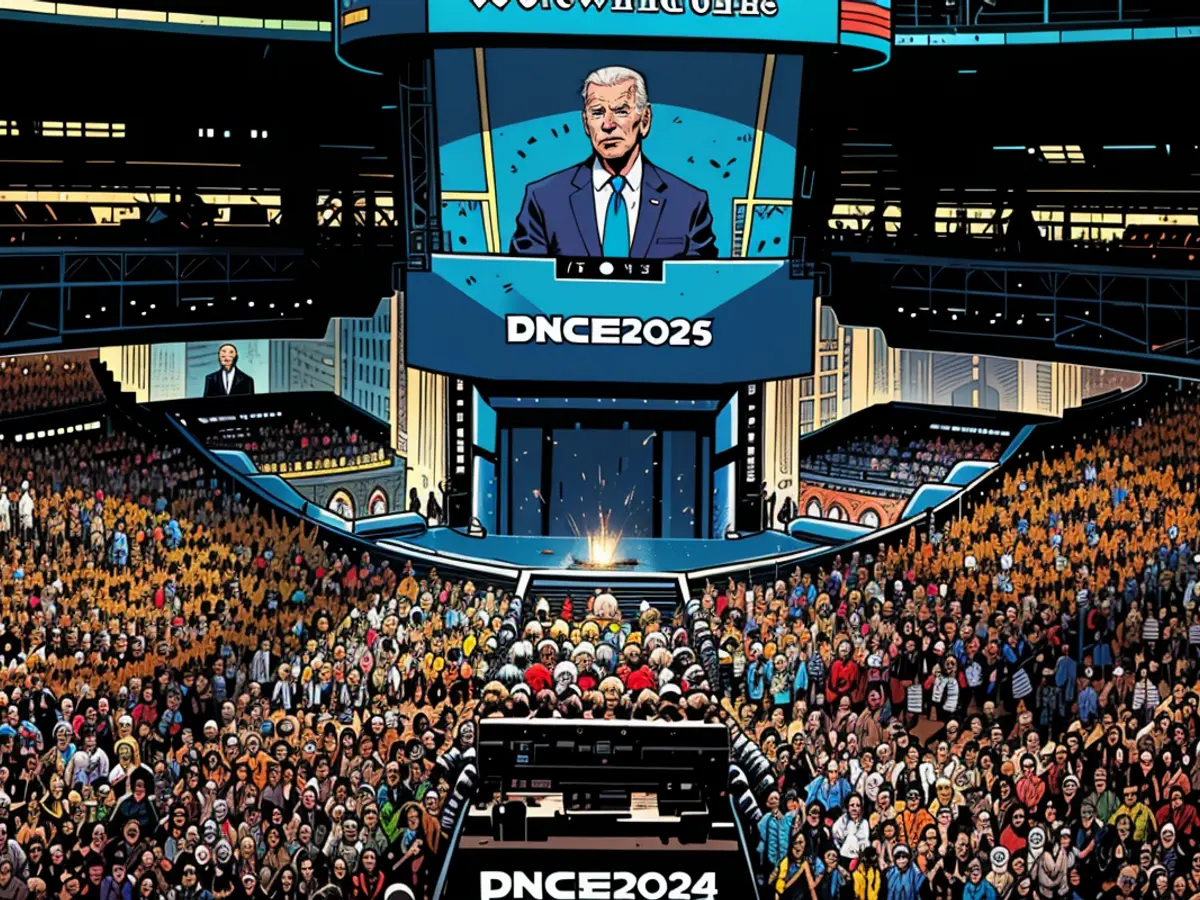In what areas Harris has restored, and failed to restore, the Democratic alliance.
When Vice President Kamala Harris stepped in as the Democratic presidential nominee following President Joe Biden last month, she had two main tasks: solidify support in areas where Biden was weak and safeguard his position in areas where he was strong.
headed to the Democratic convention in Chicago this week, a collection of polls indicates her progress on both challenges. In both national and battleground state surveys, she's recovered substantial ground lost by Biden with traditionally Democratic-leaning groups such as Black and younger voters, and made minor improvements with Latinos.
Simultaneously, in both national polls and surveys of the crucial Rustbelt battlegrounds of Michigan, Pennsylvania, and Wisconsin, Harris is matching or exceeding Biden's performance among older and working-class White voters – two groups where Biden had largely sustained his 2020 levels of support before exiting the race.
Harris' progress on these fronts has propelled her ahead of former President Donald Trump in many poll averages measuring overall national support. Crucially, it has also restored the electoral map, giving her multiple avenues to secure the 270 Electoral College votes that Biden no longer had access to after leaving the race. Her rejuvenated support among younger and non-White voters has made it possible for her to reactivate Sunbelt battlegrounds that Biden's struggles in these demographics had largely left out of reach. Furthermore, in the Rustbelt battlegrounds that represented Biden's most viable pathway to 270 Electoral College votes, Harris appears stronger than Biden due to her gains among younger and non-White voters while maintaining steady performance among White voters.
However, considerable hurdles remain for the emerging "[Kamala] coalition" in both Rustbelt and Sunbelt regions. Despite Harris' gains with younger, Black, and Latino voters, she remains below the levels Biden achieved with these groups in 2020 in most polls. Success in the major Sunbelt battlegrounds – North Carolina, Georgia, Arizona, and Nevada – hinges on Harris’ ability to approach or surpass those previous Democratic benchmarks among these demographics. Additionally, the voting blocks she needs to win over may require sustained efforts to convince and mobilize, contrary to those that have already returned to her.
In the industrial states, Harris must protect the gains she's made among working-class and older White voters, who make up a more considerable portion of the vote in these regions than in Sunbelt battlegrounds. These White voters without a college degree are likely to be receptive to GOP arguments that Harris is soft on crime and immigration and an extreme “woke” cultural liberal.
Mark Graul, a seasoned GOP operative in Wisconsin, expects Harris' support with these voters to dwindle as Republicans unleash an advertising campaign. “I think the surveys we are seeing now are at or near her peak with blue-collar White voters,” he stated. “If the Trump campaign executes its plan, the kind of messaging that resonates with working-class White voters who may be interested in the novelty of ‘we got rid of Biden and I don’t like either of those men’ will drive them back [to Donald Trump].”
It's essential to note that more working-class voters have not immediately transferred their allegiance back to Trump when Democrats replaced their 81-year-old White male nominee with a younger woman who would become the first Black woman and Indian American president. This suggests that Harris' race and gender do not universally alienate a larger group of these working-class Whites than those who have traditionally found it challenging to support any Democrat. However, it does not imply that Republicans cannot eventually peel away additional votes from her – they will need to persuade each one through their arguments and advertising instead of relying on an instinctive aversion to a woman of color nominee.
For the time being, polls generally indicate that Harris is garnering at least as much support from working-class White voters as Biden did during his 2020 race and prior to his exit from the 2024 race.
Biden didn't perform exceptionally well with working-class White voters in 2020, but he did manage to improve slightly over Hillary Clinton's performance in 2016, netting about one-third of their support, according to exit polls and the Pew Research Center's reputable validated voters study. Significantly, exit polls revealed that Biden strengthened his position among them in Michigan and Wisconsin (where he secured around two-fifths of their support) and Pennsylvania (where he took about one-third). This enhancement, coupled with an incremental uptick in support from college-educated White voters, enabled him to reclaim all three states, which Trump had disrupted in 2016 from the previously established “blue wall” – the 18 states that had voted Democratic in each presidential election from 1992 through 2012.
With numerous challenges this year, polls demonstrated Biden maintaining similar support among blue-collar White voters as he did in his initial contest against Trump. Surprisingly, Harris shows a slight improvement in this aspect. Research conducted by Marquette Law School, NPR/PBS NewsHour/Marist, and Fox News Channel in August indicated that Harris attracted 36-40% of non-college White voters, surpassing Biden's 2020 numbers and reaching the level of Barack Obama's performance in 2008 and 2012. (The Washington Post/ABC/Ipsos poll released Sunday revealed Harris not as strong, but still leading Biden in terms of White voters without degrees.) New York Times/Siena College surveys found Harris matching or surpassing Biden's 2020 results among non-college educated Whites in Michigan, Pennsylvania, and Wisconsin; subsequent surveys from these pollsters last weekend confirmed her leading Biden in North Carolina and Georgia, and matching his performance in Arizona and Nevada.
Addressing non-college degree White men could be a hurdle for Harris, but many Democrats are optimistic she can maintain a presence in these communities by garnering substantial support among white, working-class women. Biden and Hillary Clinton secured only about 35% of their votes in the exit polls, but Democrats see potential to enhance this figure since many of these women advocate for legal abortion. With concerns about Biden's age and competence now eliminated as a factor, Democrats anticipate that more of these women might express their reservations about Trump's character and behavior: in a recent national New York Times/Siena poll, roughly half of white, non-college degree women expressed doubt in Trump's capacity to excel as president.
Paul Maslin, a seasoned Democratic pollster with experience in Wisconsin, stresses the importance of defending Harris against the GOP's culturally based attacks on issues like crime and immigration directed at working-class White women to bolster her campaign. Maslin noted that Harris' vulnerability to Republican attacks is less severe than Biden's, but "we are dreaming if we don't think there is still some vulnerability. They have much better ground that they are going to get to here."
Legal abortion and disapproval of Trump's behavior and leadership style could propel Harris to expand on Biden's already considerable margins among White women with college degrees. It's worth noting that the six Republican-appointed Supreme Court justices invalidated the constitutional right to abortion after the 2020 election, while Biden was already dominating between 54-59% of college-educated White women, according to major data sources. With abortion taking on greater political significance now, Harris is poised to outperform these numbers in 2024, predict strategists from both parties.
However, preserving Biden's support among college-educated White men, a receptive audience for Trump's claims of improved economic management, will be a challenge for Harris. If she can navigate, or at least mitigate, erosion with these men (who split almost evenly in 2020), she will be well-placed to surpass Biden's 2020 performance with all college-educated Whites. Current polls indicate that Harris is on track to surpass Biden's 2020 showing among these voters in locations such as the Philadelphia suburbs, Oakland County near Detroit, and Madison, Wisconsin, allowing her to endure some erosion compared to Biden in 2020 among non-college whites and still retain those three states.
While matching Biden's strength among White voters is fundamental to Harris' prospects in the Rustbelt, overcoming his weaknesses with younger and diverse voters is crucial to her chances in the Sunbelt. Harris has made strides in this area, but her progress is still incomplete.
Over the past few weeks, surveys conducted by Democratic operatives or affiliated organizations have reported Harris improving remarkably from Biden's pre-withdrawal numbers with core party constituencies like Latinos, young people, Black men, and single women. Yet, these surveys still reveal Harris trailing her 2020 level of support with these groups. The recent New York Times/Siena surveys also indicated that Harris reclaimed over 80% of Black voters in the Industrial Midwest and Southeast but fell short of the nearly 90% or more Biden secured in 2020 in all these states. These polls further revealed Harris matching Biden's 2020 share among Latinos in Arizona but underperforming significantly in Nevada.
Veteran strategist Page Gardner, who sponsored research on single women, explained their diminished support from 2020 due to "economic factors – prices, with housing being a particularly acute concern." However, the shortfall extends beyond financial issues to a broader sense that the Biden era has not yielded the progress these voters anticipated. "Although enthusiasm and motivation have increased, there is an underlying sense of discouragement regarding things actually changing for them," Gardner said. "Like so many others in the electorate, majorities of these women feel like they are losing power."
Polling conducted by NTT Tech, a Republican firm that recently examined the views of Asian individuals in crucial election states, revealed Kamala Harris gaining ground among both Asian men and women. However, Harris is currently performing better among the former group than the latter. according to Sze Carrier, the NTT Tech co-founder and CEO. Carrier believes that Harris has the potential to match or exceed Joe Biden's 2020 Asian American voter base, but acknowledges that she is still below that level in NTT Tech's survey results.
Carrier mentioned, "She has gained significant favorability; people appreciate her; they like that she symbolizes change; overall, they have positive feelings towards her." He also added that, "especially for the undecided voters, they are eager to hear more from her on the economy."
Carrier further explained, "Her entry provides what many voters are asking for; an alternative to their previous options." He pointed out, "There's always a concern when dealing with an unproven entity: What is their stance on certain issues? I believe we will see reassurance from the campaign as they address these concerns."
On Tuesday, the Asian American Voter Project publishes a report that reported similar results. Harris showed gains across California, Texas, and Florida, where the organization focuses its efforts. Trump still performed fairly well against his improved 2020 numbers with this demographic, but Harris demonstrated potential for further growth with younger Asians. "These findings suggest remaining efforts are necessary to fully gain this influential voting bloc's support," the organization stated in a release announcing the results.
The situation with younger people is similar: While surveys have consistently shown Biden underperforming Trump amongst younger voters, recent national and state polls show Harris successfully reclaiming her lead with this demographic. Regrettably, like with the other groups, surveys have yet to reveal Harris matching Biden's near-60% support of adults under 30 in 2020.
On a recent episode of Pop Culture for Political Minds with Neichelle Guidry, AAPI Vote advisor and pollster Karthick Ramakrishnan said a recent survey he conducted found Harris attracting above 50% of younger voters against Trump. Ramakrishnan expressed concern, "I don't think she would be satisfied with this margin a few months from now, honestly." "This needs to grow into the mid-50s," he continued, "which is what I believe is necessary to feel confident about a victory in November."
Recent swing state polls released by a bipartisan team of pollsters for the Cook Political Report with Amy Walter highlight the trajectory of these shifts, which has put Harris back into contention, but not in a secure position, across the battlegrounds. The surveys found Harris leading or even with Trump in Michigan, Pennsylvania, Wisconsin, Arizona, and North Carolina; tied in Georgia; and behind only in Nevada. In May, Cook's polling showed Trump ahead or even with Biden in all seven states.
Patrick Ruffini, a Democratic pollster who conducted the survey with a Republican partner, stated that gains across various demographics helped propel Harris past Trump. "Harris is in a stronger position than Biden was in May because her campaign has won over a mix of non-college White voters in Rust Belt States... and college-educated Whites in the Sun Belt while posting gains among Black women and Asian American voters across... all the states," he said.
It's important to note that the Cook battleground state surveys also showed Harris lagging behind Trump among Black, Latino, and young voters. According to Ruffini, Harris didn't perform any better than Biden did with Latino and Asian American men across the battleground states in May. These trends mean that Trump still has a viable path to victory if he can maintain discipline during his campaign and effectively portray Harris as too liberal and inexperienced, argued Greg Strimple, the Republican pollster on the Cook survey. "There is a path for Trump," Strimple said. "It's just whether he can seize it."
Harris' gains have effectively eliminated one critical issue in the race: the much-discussed "double dissenters" who disliked both Trump and Biden. Multiple surveys, such as recent national polls by the Pew Research Center, ABC/Washington Post, and Monmouth College, as well as NTT Tech's survey of Asian American voters, have shown that there are fewer "double dissenters" negative towards both Harris and Trump compared to those negative towards both Biden and Trump. This decrease reflects Harris' success in reaching back to a significant group of Democratic-leaning voters who were hesitant to support another Biden term.
Stanley Greenberg, a long-time Democratic pollster, commented, "These were Democratic voters that we've lost. They are people that were voting strongly Democratic and felt estranged due to inflation, and Biden just didn't connect with them. Most of her gains have come from people who are leaning towards a Democratic vote and want to see her succeed."
Harris' success in renewing interest in Democratic-leaning younger, single, and non-White voters who were initially disenchanted with Biden while maintaining her support with older and working-class Whites has created a coalition powerful enough to challenge Trump in all major battlegrounds. However, her continued limitations on support on both sides of this demographic split mean that a victory in any of the pivotal states is not guaranteed.
"The trajectory prior to Biden's withdrawal seemed to anticipate a second term for Donald Trump," said Joshua Barzin, the executive director of Data for Progress, a progressive research organization. "Harris's entry has returned the race to an even footing."
Given the delicate situation, it's undeniably risky. However, with consideration to where they were a month prior, the Democratic squad assembled in Chicago right now would gladly accept these odds.
In this new phase of the political landscape, Vice President Kamala Harris has surpassed former President Donald Trump in many national poll averages, demonstrating her ability to secure Electoral College votes that were previously out of reach for President Joe Biden.
As the Democratic Party heads into elections, Harris' progress in appealing to traditionally Democratic-leaning groups like younger and non-White voters, as well as maintaining support among older and working-class White voters, is crucial for winning back key battleground states and potentially securing the 270 Electoral College votes needed for victory.







